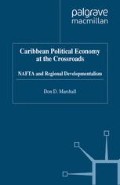Abstract
The NAFTA/FTAA process was said earlier to carry in its wake a transformative dialectic for countries that make up the Americas. A hemispheric-wide free trade area opens up possibilities for trade expansion and investment; internal restructuring; and deeper forms of regional (political-economic) collaboration. This chapter seeks to expand upon this view by looking more squarely at the NAFTA/ FTAA process and its current impact on member-states. Although caution is required when examining still unfolding scenarios, the Americas’ sphere is too important for analysis to wait on events. In any case, there is sufficient evidence, both ‘on the ground’ and within the Agreements,1 to refute the contention that the reconfiguring Americas redounds to the singular benefit of the regional hegemon (USA) alone. One of my purposes in writing this chapter is to offer an alternative to some of the excessive neophilia of the last few years. The desire to follow the trend is always a strong one among academics and social commentators alike, and this is nowhere in clearer evidence than on the question of NAFTA/FTAA and the prospects for the Caribbean sub-region. Excessive optimism or pessimism prevails with little room for nuance and sober reflection.
Access this chapter
Tax calculation will be finalised at checkout
Purchases are for personal use only
Preview
Unable to display preview. Download preview PDF.
Notes
See A. P. Gonzales (1991) ‘World Restructuring and Caribbean Economic Diplomacy’ in L. Seawar (ed.) Diplomacy for Survival. p. 4.
See Han Sung-joo (1993), ‘Fundamentals of Korea’s New Diplomacy’, Korean Focus, Vol. 1, No. 3, pp. 95–108.
See also, H. Seung (1993), ‘Tasks for Korean Economic Diplomacy’, Korean Focus, Vol., No. 2, pp. 29–51;
and M. Chung-in (1995), ‘Globalization: Challenges and Strategies’, Korean Focus, Vol. 3, No. 3, pp. 62–77.
For more on this, see the feature report by B. Larmer, ‘The Banana Wars’, in Newsweek, 28 April 1997.
See CEPAL (1992), UN Economic Commission for Latin America and the Caribbean Social Equity and Changing Production Patterns: An Integrated Approach, Santiago.
See N. Duncan (1994), ‘Mechanisms of Impoverishment in the Anglophone Caribbean: The Role of the Bretton Woods Institutions and Caribbean NGO Recommendations’, a Paper, Cave Hill: University of the West Indies. p. 35.
See Raghavan, C. (1991), Recolonization: Multilateral Institutions and International Trade.
See H. Addo (1991), ‘The New World Order and the Prospects for Global Social Justice: A Third World Perspective’, a Paper, St. Augustine: Institute of International Relations, University of the West Indies. p. 19.
See a presentation of the various views in P. Wonnacott (1987), ‘The United States and Canada: The Quest for Free Trade’, Series No. 16, Policy Analyses in International Economics, Washington, D.C.: Institute for International Economics; and J. Hosten-Craig (1994), ‘CARICOM Countries and the NAFTA: A Canadian Perspective’, a Commissioned Study prepared for the Caricom Secretariat.
Also see comments in the following report: UN Food and Agricultural Organization (1994), ‘Effects of the North American Free Trade Agreement on Caricom Countries Agricultural Exports’, Washington DC: The United Nations.
For a collection of these views, see R. J. Ahearn (1992), The Future of Western Hemisphere Trade Relations: Proceedings of a CRS Seminar, Washington, DC, Congressional Research Service: Library of Congress.
See World Bank (1992) World Development Report 1992, Washington DC: The World Bank.
See Thurow, L. (1992), Head to Head: The Coming Battle Among Japan, Europe and America.
See Waverman, L. (1994), ‘Post-NAFTA: Can the USA, Canada and Mexico Deepen their Economic Relationships?’ a Research Report, Toronto: University of Toronto.
See World Bank (1992), World Development Report, 1992.
See OECD (1983) Economic Survey Canada, Paris: OECD.
See Williams, Frances (1996), ‘Canada’s Trade Moves Closer to U.S., says WTO’, Financial Times (November 20).
See M. Pastor and C. Wise (1994), ‘The Origins and Sustainability of Mexico’s Free Trade Policy’, International Organization, No. 3, pp. 459–489.
See B. P. Bosworth, R. Z. Lawrence, and N. Lustig (eds), (1992) NAFTA-Assessing the Impact, n.p.
See C. Gabriel and L. Macdonald (1994), ‘NAFTA, Women and Organising in Canada and Mexico: Forging a “Feminist Internationality”’, Millennium: Journal of International Studies, Vol. 23, No. 3, pp. 535–562. p. 541.
See M. H. Marchand (1994), ‘Gender and the New Regionalism in Latin America: Inclusion/Exclusion’, Third World Quarterly, Vol. 15, No. 1, pp. 63–76.
See P. Martin (1993), Trade and Migration: NAFTA and Agriculture, Washington, D.C.: Institute for International Economics.
See E. Rodriguez (1993), ‘Central America: Common Market, Trade Liberalization, and Trade Agreements’, a Research paper, Notre Dame: Kellog Institute for International Studies, University of Notre Dame.
See D. E. Lewis (1994), ‘Assessment and Review of the Central American Negotiations Towards the NAFTA and Their Possible Implications for Caricom Trade Negotiation Initiatives’, a Commissioned Study prepared for the Caricom Secretariat.
See Julia Scheeres (1996), ‘In Praise of NAFTA’, in El Financiero Weekly International, 31 March.
See the findings in World Bank (1995), Global Trade Information Services.
See Rick Wills (1996), ‘Economic Indicators Improve’, El Finaciero Weekly International, December.
See Salvador Rico (1996), ‘The Mexico-Canada Alliance’, El Financiero Weekly International (June).
As noted by R. Erzan and A. Yeats (1992) Free Trade Agreements with the United States: What’s In It for Latin America? Washington, DC: The World Bank;
and A. Mclntyre (1994) ‘An Analysis of Quantitative Estimates of the Trade and Investment Impact of NAFTA’, a Commissioned Report prepared for the Caricom Secretariat.
Author information
Authors and Affiliations
Copyright information
© 1998 Don D. Marshall
About this chapter
Cite this chapter
Marshall, D.D. (1998). NAFTA/FTAA and the New Articulation in the Americas: ‘Re-colonization’ or Structural Opportunity?. In: Caribbean Political Economy at the Crossroads. International Political Economy Series. Palgrave Macmillan, London. https://doi.org/10.1057/9780230389861_6
Download citation
DOI: https://doi.org/10.1057/9780230389861_6
Publisher Name: Palgrave Macmillan, London
Print ISBN: 978-1-349-40328-8
Online ISBN: 978-0-230-38986-1
eBook Packages: Palgrave Political & Intern. Studies CollectionPolitical Science and International Studies (R0)

